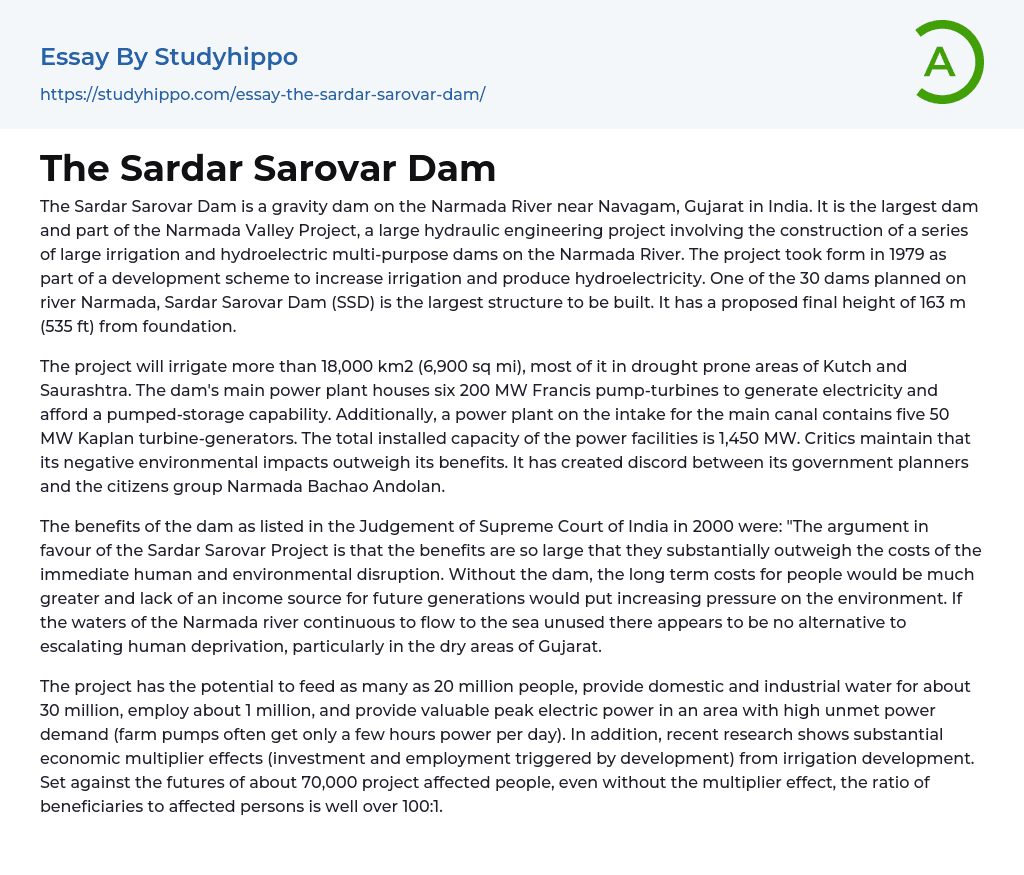The Sardar Sarovar Dam, situated near Navagam in Gujarat, India, is the largest dam on the Narmada River. It plays a vital role in the Narmada Valley Project, which aims to construct multiple large dams for irrigation and hydroelectric purposes. This project was initiated in 1979 with the goal of improving irrigation facilities and generating hydroelectric power. Once completed, the Sardar Sarovar Dam (SSD) will be the largest structure among the planned 30 dams on the Narmada River. It is proposed to have a final height from its foundation of 163 m (535 ft).The project's main goal is to provide irrigation for drought prone regions of Kutch and Saurashtra, covering over 18,000 km2. It consists of a dam with six 200 MW Francis pump-turbines for generating electricity and pumped-storage capability. Additionally, there is a power plant at the main canal intake feat
...uring five 50 MW Kaplan turbine-generators. In total, the power facilities have an installed capacity of 1,450 MW. However, some critics argue that the project's negative environmental impacts outweigh its benefits, causing disagreements between government planners and the citizens group Narmada Bachao Andolan.
The Supreme Court of India in 2000 listed the benefits of the dam as follows: "The Sardar Sarovar Project is justified by the argument that the advantages are significant enough to outweigh the negative effects on humans and the environment. Not having the dam would result in much higher long-term costs for people and would lead to increased environmental pressure due to lack of income sources for future generations. If the waters of the Narmada river continue to flow unused to the sea, it seems that escalating human deprivation, especially in Gujarat's
arid regions, would be inevitable."
The project has the potential to benefit a large number of people. It can feed around 20 million people, supply water to about 30 million for domestic and industrial use, employ approximately 1 million individuals, and provide much-needed electricity in an area with high power demand. This is especially important as many farm pumps currently only receive a few hours of power each day. Furthermore, recent studies have shown that irrigation development can have significant economic multiplier effects, triggering investment and employment opportunities. Even without considering this multiplier effect, when compared to the approximately 70,000 individuals who may be affected by the project, the ratio of beneficiaries to those affected is more than 100:1.
- Bottled Water essays
- John Locke essays
- 9/11 essays
- A Good Teacher essays
- A Healthy Diet essays
- A Modest Proposal essays
- A&P essays
- Academic Achievement essays
- Achievement essays
- Achieving goals essays
- Admission essays
- Advantages And Disadvantages Of Internet essays
- Alcoholic drinks essays
- Ammonia essays
- Analytical essays
- Ancient Olympic Games essays
- APA essays
- Arabian Peninsula essays
- Argument essays
- Argumentative essays
- Art essays
- Atlantic Ocean essays
- Auto-ethnography essays
- Autobiography essays
- Ballad essays
- Batman essays
- Binge Eating essays
- Black Power Movement essays
- Blogger essays
- Body Mass Index essays
- Book I Want a Wife essays
- Boycott essays
- Breastfeeding essays
- Bulimia Nervosa essays
- Business essays
- Business Process essays
- Canterbury essays
- Carbonate essays
- Catalina de Erauso essays
- Cause and Effect essays
- Cesar Chavez essays
- Character Analysis essays
- Chemical Compound essays
- Chemical Element essays
- Chemical Substance essays
- Cherokee essays
- Cherry essays
- Childhood Obesity essays
- Chlorine essays
- Classification essays




